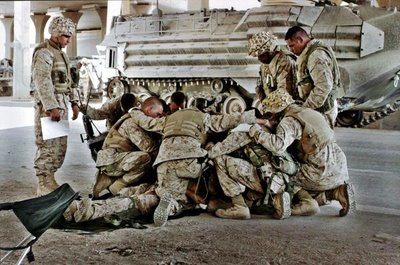By Donna Miles
American Forces Press Service
NORTH ARABIAN GULF, Oct. 18, 2006 - The
USS Iwo Jima can unleash tremendous military force by air, land and sea, but the crew takes pride in offering something the ship's captain says is equally important: the ability to reduce suffering and save lives.
"This ship is unique in that it's not just projecting power, but also has the capacity to do a great deal of assistance," Navy Capt. Mike "The Sheriff" Walley told civilian business and community leaders participating in the Joint Civilian Orientation Conference aboard the ship.
The Defense Department's JCOC program has been introducing civilian "movers and shakers" to the military since 1948 by showing them military operations and giving them an opportunity to see men and women in uniform on the job.
"We're not just about taking lives, we're about saving lives," Walley told the JCOC group. "That's one of the things we're proud of -- that we bring not just a warfighting capacity, but also a humanitarian capacity."
Last summer, the
USS Iwo Jima got the chance to do just that as it was preparing to return to its home port of Norfolk, Va., Walley told the group. Hurricane Katrina had just devastated the U.S. Gulf Coast, and
Iwo Jima was called in to provide a command and control platform and a floating hospital for people who couldn't get care in New Orleans hospitals.
At the same time,
Iwo Jima's crew assisted in search and rescue operations, plucking almost 3,400 people from rooftops and saving them from the rising waters.
"This wasn't a new mission," Walley told the JCOC group. "When Katrina happened, we knew exactly what to do."
Crewmembers said they get a lot of gratification from helping fellow Americans in need.
"It really felt good to be a part of something like that," said Airman Courtney Young, who's been an aviation mechanic with
Iwo Jima for the past two years. "You get a lot of satisfaction when you turn on CNN and can see our boat doing a lot of good."
Three football fields long, but shorter than an aircraft carrier,
Iwo Jima and its 1,100 sailors provide the platform that delivers the 1,600 to 1,800 Marines it typically carries to any contingency in their region.
The ship carries 29 aircraft, including Marine Corps AV-8B "Harriers" that provide air defense and close-ground support, CH-53 "Super Stallions" and CH-46E "Sea Knight" that ferry troops and supplies and AH-1W "Super Cobras" that provide close-in air support.
In addition, the
Iwo Jima's Landing Craft Air Cushion is capable of delivering Marines along with their vehicles and equipment for an amphibious assault.
The JCOC participants got a firsthand look at these military capabilities, took a spin in an LCAC at speeds hitting 45 knots, and watch Harriers take off and land from
Iwo Jima's flight deck.
In addition to its combat capability,
Iwo Jima contributes to the U.S. maritime mission in a way a traditional carrier simply can't, Walley said. "We call a carrier a single-dimensional ship" that projects air power, he said. "This ship is multi-dimensional.
"Just over four months into its current deployment,
USS Iwo Jima is once again demonstrating those multi-dimensional capabilities.
Since leaving Norfolk in early June,
Iwo Jima already has helped evacuate 14,900 American citizens in Lebanon to safety before providing more traditional support to operations in both Afghanistan and Iraq. The ship is currently operating in the North Arabian Gulf, about 60 miles from the Kuwaiti coast.
Iwo Jima's crew "has done more since they came out here than the three previous strike groups," Marine Corps Brig. Gen. Carl Jensen, commander of Task Force 59, told the group. "This strike group has really done it and done it all - and made it look easy."
Jensen called the Lebanon evacuation mission a big feather in
Iwo Jima's hat. "It was a huge, joint effort," Jensen said of the mission that was moving 4,000 people a day at its peak. "But the lion's share was carried out by the Navy and Marine Corps, and we're really proud to have played a role."
The ability to react quickly to a wide variety of missions is a hallmark of U.S. naval forces, Vice Adm. Patrick M. Walsh, commander of U.S. Naval Forces Central Command, told the group during a briefing yesterday. "The advantage of maritime forces is that you can move quickly and be responsive to events on the ground," he said.
He cited humanitarian and disaster relief as one of the three key maritime missions in the region, along with maritime security operations and consequence management.
In supporting a humanitarian or disaster relief mission,
Iwo Jima can transport people, deliver food, make drinkable water and provide medical care in an onboard facility that includes operating rooms, X-ray rooms, a blood bank, laboratories and patient wards, Walley told the group. In a catastrophic situation, most of the ship's hangar bay and flight deck would provide an overflow triage area.
Members of the
Iwo Jima crew said they feel good about their ability to provide, not just combat power, but also life-saving support to people in need. "In the end, I think all warriors like to believe ... that they are helping provide a better world for a country they are in conflict with," Walley said.
Participants in the JCOC program said they were wowed by what they observed on
Iwo Jima. "It was awesome, amazing, a one-in-a-lifetime opportunity," said Keith Cooley, chief executive officer for Focus: Hope, based in Detroit."It totally exceeded my expectations - not just the machinery, but the people," Cooley continued. "They're young, honest people of integrity. I'm pretty damned impressed."
The first U.S. defense secretary, James V. Forrestal, created the JCOC in 1948 to introduce civilian "movers and shakers" with little or no military exposure to the workings of the armed forces. Nearly six decades later, it remains DoD's premier civic leader program. Participants are selected from hundreds of candidates nominated by military commands worldwide and pay their own expenses throughout the conference.
We at Vested Power of the People are mighty proud of our men and women sailors who serve our country and the world.God Bless the whole of our military.God Bless America.[Web Version:
http://www.defenselink.mil/News/NewsArticle.aspx?ID=1680]




